- News
- Reviews
- Bikes
- Components
- Bar tape & grips
- Bottom brackets
- Brake & gear cables
- Brake & STI levers
- Brake pads & spares
- Brakes
- Cassettes & freewheels
- Chains
- Chainsets & chainrings
- Derailleurs - front
- Derailleurs - rear
- Forks
- Gear levers & shifters
- Groupsets
- Handlebars & extensions
- Headsets
- Hubs
- Inner tubes
- Pedals
- Quick releases & skewers
- Saddles
- Seatposts
- Stems
- Wheels
- Tyres
- Tubeless valves
- Accessories
- Accessories - misc
- Computer mounts
- Bags
- Bar ends
- Bike bags & cases
- Bottle cages
- Bottles
- Cameras
- Car racks
- Child seats
- Computers
- Glasses
- GPS units
- Helmets
- Lights - front
- Lights - rear
- Lights - sets
- Locks
- Mirrors
- Mudguards
- Racks
- Pumps & CO2 inflators
- Puncture kits
- Reflectives
- Smart watches
- Stands and racks
- Trailers
- Clothing
- Health, fitness and nutrition
- Tools and workshop
- Miscellaneous
- Buyers Guides
- Features
- Forum
- Recommends
- Podcast
review
£2,400.00
VERDICT:
Stiff yet highly comfortable speed machine, now with a helping of aero efficiency
Stiff and efficient frameset
Comfortable
Aero features
Not the lightest in this build
Weight:
8,780g
Contact:
At road.cc every product is thoroughly tested for as long as it takes to get a proper insight into how well it works. Our reviewers are experienced cyclists that we trust to be objective. While we strive to ensure that opinions expressed are backed up by facts, reviews are by their nature an informed opinion, not a definitive verdict. We don't intentionally try to break anything (except locks) but we do try to look for weak points in any design. The overall score is not just an average of the other scores: it reflects both a product's function and value – with value determined by how a product compares with items of similar spec, quality, and price.
What the road.cc scores meanGood scores are more common than bad, because fortunately good products are more common than bad.
- Exceptional
- Excellent
- Very Good
- Good
- Quite good
- Average
- Not so good
- Poor
- Bad
- Appalling
The Cannondale SuperSix Evo Carbon Disc 105 is a stiff and efficient road bike that manages to offer loads of comfort and now aero features too.
The SuperSix Evo has always been known for its frame stiffness and that remains a key feature after a major redesign introduced to the world a little over a year ago. Stomp on the pedals and everything feels taut going on solid. Getting out of the saddle and chucking everything I have at a power climb, the bottom bracket remains steadfastly central. It's a feature you can't fail to notice.
> Find your nearest dealer here
Cannondale offers the SuperSix Evo Disc frame in a hi-mod version (complete bikes starting at £4,000) and the slightly heavier and more affordable standard version that we have here. Our 58cm complete bike hit the road.cc Scales of Truth at 8.78kg, which is a decent rather than spectacular weight for a disc brake bike at this price.
The SuperSix Evo is an eager bike. It gets cracking when you put in the power, that rigidity giving you the firmest of platforms from which to launch your assaults.
The handling is sharp. If you want to switch your line around other riders, the SuperSix Evo is about as precise as it gets, and cornering hard and fast feels perfectly composed, so you're inclined to lay off the brakes that fraction longer next time around. In terms of behaviour, there's very little to fault here.
You also get a high level of comfort for a bike with such a sharp focus on performance. Cannondale says that the new SAVE (Synapse Active Vibration Elimination) stays, plus a new internal seat clamp and HollowGram 27 KNOT seatpost, improve compliance by 18% over the old SuperSix. My arse doesn't have the capacity to gauge things that accurately, but I could ride this bike for hours without feeling at all shaken up or knocked about. This is probably the SuperSix Evo's most surprising feature.
The fact that the seatstays are now dropped, falling into line with bikes from the vast majority of other big brands, might help here, although Trek, which is still holding out on this front, says that dropping the seatstays doesn't make a whole heap of difference in terms of comfort.
It could be that the now slightly sloping top tube leaving a longer section of exposed seatpost is more important. The seatpost in question is aluminium and super skinny. Like the frame tubes, it is shaped with aerodynamics in mind so it's roughly D-shaped, measuring just 22mm across according to the trusty road.cc vernier callipers, and 27mm front to rear. It flexes relatively easily to take the edge off any nasties you encounter in the road surface.
The saddle is a good one too: a Prologo Nago. My preference would be for a profile that's a touch flatter and a little less humpbacked (Prologo describes it as semi-round), but that's a purely personal thing. It offers good cushioning and a generous amount of give in the shell to filter out vibration.
If you want still more comfort, the new SuperSix Evo has clearance for 30mm tyres with 6mm of space around them.
Not surprisingly, the stock tyres are considerably narrower; they're Vittoria Zaffiro Pro Slicks in a 25mm width. We measured them at over 27mm wide on Cannondale's RD 2.0 Disc wheels.
All of this adds up to a bike that feels impressively smooth over rough roads with good bump absorption both front and rear. Let's not go overboard – you're not getting an endurance bike-style fully cosseted ride here – but comfort is one of those things you usually only think about when there's not a lot of it around, and I certainly didn't need to dwell on it much here.
The SuperSix is comfortable enough that the ride feels calm and composed even over pitted, jagged road surfaces, absorbing the irregularities rather than skittering about when you ride fast into a bumpy downhill bend.
Geometry
One other factor that has a bearing on comfort is the geometry which Cannondale has altered on this latest incarnation of the SuperSix Evo. As mentioned, I've been riding a 58cm model. The 2019 version of this bike had a stack of 58.4cm and a reach of 39.9cm, so the stack/reach was 1.46.
This new version has a stack of 59.4cm and a reach of 39.5cm, so the stack/reach is 1.5 (bear in mind that this is high partly because we're talking about a large bike; the stack/reach of the 54cm frame is 1.44). The front end is a little higher and a little closer to the saddle than it was before.
> Bike geometry 101: Why are stack and reach important?
In for a penny, in for a pound – let's chuck in a few more figures. The 58cm SystemSix aero road bike has a stack of 58.0cm and a reach of 39.8mm, giving a stack/reach of 1.46.
Why the difference? The main factor is that Cannondale has made the head tube of the SuperSix Evo longer than previously – 18.8cm versus 17.5cm on the 58cm model – so the riding position is more upright (given the same stack of headset spacers, obviously).
Will that suit you? It depends what you're after. Getting down on the drops for long periods is just a touch easier on the back and neck than previously. I found myself with my hands positioned down there a lot, and that's no bad thing. It's still an aggressive, speed-focused setup.
Frame features
We've so far not covered the changes that Cannondale has made to the SuperSix Evo's frameset in much depth, but the latest update has been radical.
Previously, the SuperSix Evo had a distinctive silhouette: slim (or at least slim-ish) round tubes, a horizontal top tube, long seatstays... It wasn't exactly traditional looking, but it was in that direction.
That has all changed now. If you want to know about the updates in detail, head over to our story covering the launch, but in short Cannondale has given the SuperSix an aero makeover – as Specialized has since done with its Tarmac, Trek has done with its Emonda, and Giant has done with its TCR. It's all the rage. Lightweight bikes have gone aero for those who want the lot.
Most notably, Cannondale has introduced truncated aerofoil tube profiles to reduce drag, dropped the seatstays to improve comfort and aero efficiency, made the majority of hose/cable routing internal, and now offers an aero handlebar and stem system, although not on this particular model (you have to pay £3,300 for the SuperSix Evo Carbon Disc Ultegra if you want that).
Cannondale reckons that the changes add up to the equivalent of a 30 watt saving at 30mph (48.3km/h) compared with the previous SuperSix Evo. That's a huge difference, especially when you consider the taller head tube.
There's no way of checking that claim short of collecting our own wind tunnel data, so we're reporting it rather than verifying it. For what it's worth, the changes mean that the SuperSix Evo is now more in line with other bikes of its genre, the development work having been undertaken by engineer Nathan Barry who has a PhD in Applied Aerodynamics. Barry's first project for Cannondale was the excellent SystemSix aero bike, upon which some of the SuperSix's features are based.
With an eye on maintaining the stiffness and low weight of the previous generation Supersix while at the same time reducing drag, Cannondale developed a new family of tube shapes.
'The technology that really helped make this possible was the tube cross-section studies,' said Nathan Barry. 'This started as parallel research in advance of what became the new Evo. I was trying to find a way that we could reduce drag on a bike without changing the stiffness or increasing the weight, but also trying to keep a classic low profile aesthetic.
'After iterating through many different combinations of highly truncated low aspect ratio airfoil sections, we arrived at the tubes you see on this new SuperSix Evo. The down tube is the same circumference as the previous generation bike (so the amount of material is the same), it is really just redistributed into this new form. That allows us to maintain stiffness and weight while reducing drag.'
Front end
Most mid to high-end bikes launched over the past couple of years have fully (or near enough) internal cables and hoses but on the SuperSix Evo the gear cables run externally between the ends of your handlebar tape and a plate at the top of the down tube.
If you go for a bike with Shimano Di2 electronic shifting, the wires run along the underside of Cannondale's HollowGram KNOT stem, a cover hiding them away. Our review bike has cable-operated shifting and a standard Cannondale 3 6061 alloy stem.
On the models with disc brakes, like ours, the hoses duck into the top of the head tube via a proprietary headset cover and run internally where they need to go. The headset spacers are gated, by the way, so you can add/remove them without going through the rigmarole of disconnecting the brakes or, on Di2 models, the shift wires.
The setup on our review bike – mechanical shifting with a standard-type stem – already looks a little old fashioned compared with something like a Shimano 105-equipped Trek Emonda SL 5 where the gear cables run into the top of the head tube alongside the hoses. A SuperSix Evo with electronic shifting is much tidier, but you're looking at £5,000 for the model with an Ultegra Di2 groupset.
One result of Cannondale's system is that you can't turn the handlebar quite as far as you otherwise could (it's the same on the SystemSix) because the movement of the fork is restricted. A distinct thud tells you when you've reached the limit.
In practice, it's only relevant when you're doing a U-ey at walking pace; you never reach the stop point when you're going any faster than that – it would be too tight a turn.
The build
Built up with Shimano 105 components, our review bike is the most affordable disc brake SuperSix Evo, although a rim brake model is available for £2,000 (there's a rim brake Shimano Ultegra model for £2,500 too).
The shifters, derailleurs, hydraulic disc brakes, cassette and chain are all 105, but you get a Cannondale One crankset with a 30mm diameter spindle. You won't find a Shimano chainset on any SuperSix Evo because the brand doesn't do 30mm spindles. The Cannondale One is a little heavier than a Shimano alternative but it contributes to the mega-stiff pedalling platform.
I won't go into huge detail on Shimano 105 because we've covered it sooooo many times before (and if I write too many more words sub-editor Tass is going to kick right off) but it is a fine, upstanding member of the Shimano community, that'll give you a nod in the street and probably stick a couple of quid in the charity box from time to time too. You know, a solid, super-dependable salt of the earth type. It works every bit as well as Ultegra and Dura-Ace, it's just a little heavier.
The chainset is 52/36-tooth matched to an 11-30t cassette and I reckon that's spot on for a bike of this type. It'll keep you progressing on tough climbs and allow you to keep the power on at high speed.
The handlebar and stem are standard-style 6061 aluminium and together offer a really strong front end, although if you're attracted by the efficiency claims made for the SuperSix Evo you'll probably yearn for a model that features the aero-optimised HollowGram Save SystemBar and HollowGram KNOT stem. The least expensive of these is the SuperSix Evo Carbon Disc Ultegra at £3,300.
The Cannondale/Formula wheels are decent enough but they don't really suit the character of the SuperSix Evo in that the rims are shallow. Let's be honest, this bike is crying out for deeper section rims. The 35mm-deep HollowGram carbon clinchers on the SuperSix Evo Carbon Disc Ultegra are more the ticket – although, of course, that bike is considerably more expensive. Maybe you already have favourite wheels that you'd swap onto this bike anyway, in which case you're laughing. We nearly got that Ultegra model in on test and I'd seriously consider opting for that one if your budget allows. It looks like the better deal.
Money bit
That brings us seamlessly to the money bit. The obvious comparison is with the Shimano 105-equipped Trek Emonda SL 5 that's a little cheaper at £2,275. We've not reviewed that model but Stu rode the Emonda SL 6 Pro which features the same frameset. He said that the stiffness throughout the fork and the lower half of the frame is very impressive, and called it a 'firm yet fun ride'.
In terms of components, there's not a great deal to choose between the SuperSix Evo Carbon Disc 105 and the Emonda SL 5.
> Your complete guide to Shimano road bike groupsets
The 2020 Merida Reacto Disc 5000 that we reviewed was £2,500 and the 2021 model is a little cheaper at £2,450. This model has Shimano Ultegra brakes, shifters and derailleurs – a level higher than 105 – although the chainset is non-series Shimano RS510.
Stu said, 'It's not the lightest [8.97kg for size M/L], or most comfortable, but if speed is your main goal then the Reacto Disc 5000 delivers.'
The Specialized Tarmac Disc Sport that we reviewed earlier in the year was £2,350. That bike has essentially become the Specialized Tarmac SL 6 Sport for 2021. It features a Shimano 105 groupset and DT R470 Disc wheels which aren't the flashiest, lightest or most aero ever, but they are dependable.
We said, 'Race-ready performance with great handling and decent comfort, the Tarmac Disc Sport shines everywhere bar value.'
At £2,750, the Tarmac SL6 Sport is £350 more than the Cannondale SuperSix Evo Carbon Disc 105.
Conclusion
Cannondale took a risk in updating the SuperSix Evo so radically because the previous version was so popular, but it's a gamble that has paid off. It has managed to retain all of the good bits and thrown aero efficiency into the mix.
The SuperSix Evo Carbon Disc 105 is super-stiff and responsive and far, far smoother than you might expect of a race bike. It's also highly upgradeable, the frameset being well worthy of some mid-depth carbon wheels as and when funds allow.
Verdict
Stiff yet highly comfortable speed machine, now with a helping of aero efficiency
road.cc test report
Make and model: Cannondale SuperSix Evo Carbon Disc 105
Size tested: 58cm
About the bike
List the components used to build up the bike.
Cannondale lists:
FRAMESET
Frame BallisTec Carbon, integrated cable routing w/ Switchplate, 12x142 Speed Release thru-axle, SAVE, PF30a, flat mount disc, integrated seat binder
Fork BallisTec Carbon, SAVE, integrated crown race, 12x100mm Speed Release thru-axle, flat mount disc, internal routing, 1-1/8" to 1-1/4" steerer and 55mm offset (44-54cm), 1/8" to 1-3/8' steerer and 45mm offset (56-62cm)
Headset Integrated, 1-1/8" - 1-1/4" (44-54cm), 1-1/8" - 1-3/8" (56-62cm)
Bottom Bracket Cannondale Alloy PressFit30
Chain Shimano HG601, 11-speed
Chainset Cannondale 1, BB30a, 52/36
Front Derailleur Shimano 105, braze-on
Rear Cogs Shimano 105, 11-30, 11-speed
Rear Derailleur Shimano 105 GS
Shifters Shimano 105, 11-speed
Brake Levers Shimano 105
Brakes Shimano 105 hydraulic disc, 160/160mm RT64 rotors
Handlebar Cannondale 3, 6061 alloy, Compact
Tape Cannondale Bar Tape, 3.5mm
Saddle Prologo Nago RS STN
Seatpost HollowGram 27 KNØT, Alloy, 2 bolt clamp, 330mm, 15mm offset
Stem Cannondale 3, 6061 Alloy, 31.8, 7°
Front Hub Formula CL-712, 12x100 centerlock
Rear Hub Formula RXC-400, 12x142 centerlock
Rims Cannondale RD 2.0 Disc, double wall w/ eyelet, 28h
Spokes Stainless Steel, 14g
Tyres Vittoria Zaffiro Pro Slick, 700 x 25mm
Tell us what the bike is for and who it's aimed at. What do the manufacturers say about it? How does that compare to your own feelings about the bike?
Cannondale says, "Fast, just got faster. A pure road bike. Light, smooth and ultra fast. The evolution of the classic race machine."
Cannondale lists these highlights
* Lightweight low-drag BallisTec carbon frameset
* Shimano 105 hydro disc group
* Cannondale 1 crank
Cannondale says it is built for speed, agility, and handling, and "thrives in competition, the open road, up and down hills".
You get the picture, it's a performance-minded road bike aimed at racing or at least riding fast.
Where does this model sit in the range? Tell us briefly about the cheaper options and the more expensive options
The SuperSix Evo Carbon Disc 105 is the most affordable disc brake model in the range. Models with the aero-optimised Hollowgram handlebar and stem (which hide gear hoses completely) start at £3,300.
Frame and fork
Overall rating for frame and fork
9/10
Tell us about the build quality and finish of the frame and fork?
The frameset is exceptionally good and could easily take higher level wheels (as other models in the range do).
Tell us about the materials used in the frame and fork?
We have the standard version of the frame that uses what Cannondale calls BallisTec Carbon. Complete bikes with a lighter Hi-Mod frameset cost from £4,300.
Tell us about the geometry of the frame and fork?
Cannondale has altered the geometry with this version of the SuperSix Evo, lengthening the head tube a little. It's slightly more relaxed than previously, although clearly still focused on a flat back riding position. I've covered this in more detail in the main body of the review.
How was the bike in terms of height and reach? How did it compare to other bikes of the same stated size?
I was on the 58cm frame with a 57.8mm top tube, which is about normal for a road bike of this kind.
The stack is a little higher than on previous versions of the SuperSix Evo and the reach is a little shorter. It's a significant tweak but this still feels like a race bike.
Riding the bike
Was the bike comfortable to ride? Tell us how you felt about the ride quality.
I found the level of comfort the most surprising feature of the SuperSix Evo.
Did the bike feel stiff in the right places? Did any part of the bike feel too stiff or too flexible?
Head tube stiffness feels high and it feels even higher at the bottom bracket.
How did the bike transfer power? Did it feel efficient?
This is probably the SuperSix Evo's strongest suit. It feels like nothing is wasted.
Was there any toe-clip overlap with the front wheel? If so was it a problem?
Just a touch, and not a problem.
How would you describe the steering? Was it lively neutral or unresponsive? I'd call it sharp.
Which components had the most effect (good or bad) on the bike's comfort? would you recommend any changes?
I liked the Prologo Nago saddle, but I'd swap to something flatter long term. If you want more comfort you could always swap to wider tyres or run a tubeless setup.
Rate the bike for efficiency of power transfer:
9/10
Rate the bike for acceleration:
8/10
Rate the bike for sprinting:
8/10
Rate the bike for high speed stability:
7/10
Rate the bike for cruising speed stability:
7/10
Rate the bike for low speed stability:
7/10
Rate the bike for flat cornering:
9/10
Rate the bike for cornering on descents:
9/10
Rate the bike for climbing:
7/10
The drivetrain
Rate the drivetrain for performance:
8/10
Rate the drivetrain for durability:
8/10
Rate the drivetrain for weight:
8/10
Rate the drivetrain for value:
8/10
Wheels and tyres
Rate the wheels for performance:
7/10
Rate the wheels for durability:
7/10
Rate the wheels for weight:
7/10
Rate the wheels for comfort:
7/10
Rate the wheels for value:
7/10
Rate the tyres for performance:
5/10
Rate the tyres for durability:
7/10
The tread is fairly thick which helps with durability.
Rate the tyres for weight:
5/10
Rate the tyres for comfort:
6/10
Tell us some more about the tyres. Did they work well in the conditions you encountered? Would you change the tyres? If so what for?
I'm not a huge fan of these tyres. They're not particularly light or quick. I'd be upgrading them. They're the least impressive part of the spec.
Controls
Rate the controls for performance:
8/10
Rate the controls for durability:
8/10
Rate the controls for weight:
8/10
Rate the controls for comfort:
8/10
Rate the controls for value:
8/10
Your summary
Did you enjoy riding the bike? Yes
Would you consider buying the bike? Yes
Would you recommend the bike to a friend? Yes
How does the price compare to that of similar bikes in the market, including ones recently tested on road.cc?
The Shimano 105-equipped Trek Emonda SL 5 is a little cheaper at £2,275. We've not reviewed that model but Stu rode the Emonda SL 6 Pro which features the same frameset. He said that the stiffness throughout the fork and the lower half of the frame is very impressive, and called it a 'firm yet fun ride'. In terms of components, there's not a great deal to choose between the SuperSix Evo Carbon Disc 105 and the Emonda SL 5.
The 2020 Merida Reacto Disc 5000 that we reviewed was £2,500 and the 2021 model is a little cheaper at £2,450. This model has Shimano Ultegra brakes, shifters and derailleurs – a level higher than 105 – although the chainset is non-series Shimano RS510. Stu said, 'It's not the lightest [8.97kg for size M/L], or most comfortable, but if speed is your main goal then the Reacto Disc 5000 delivers'.
The Specialized Tarmac Disc Sport that we reviewed earlier in the year was £2,350. That bike has essentially become the Specialized Tarmac SL 6 Sport for 2021. It features a Shimano 105 groupset and DT R470 Disc wheels which aren't the flashiest, lightest or most aero ever, but they are dependable.
We said, 'Race-ready performance with great handling and decent comfort, the Tarmac Disc Sport shines everywhere bar value'.
At £2,750, the Tarmac SL6 Sport is £350 more than the Cannondale SuperSix Evo Carbon Disc 105.
In the light of all that, the SuperSix Evo is pretty good value. It has an excellent frameset and is highly upgradeable.
Rate the bike overall for performance:
9/10
Rate the bike overall for value:
7/10
Use this box to explain your overall score
It's about the most solid 8 possible. It's very good.
About the tester
Age: 48
I usually ride: My best bike is:
I've been riding for: Over 20 years I ride: Most days I would class myself as: Expert
I regularly do the following types of riding: commuting, club rides, sportives, general fitness riding,
Mat has been in cycling media since 1996, on titles including BikeRadar, Total Bike, Total Mountain Bike, What Mountain Bike and Mountain Biking UK, and he has been editor of 220 Triathlon and Cycling Plus. Mat has been road.cc technical editor for over a decade, testing bikes, fettling the latest kit, and trying out the most up-to-the-minute clothing. He has won his category in Ironman UK 70.3 and finished on the podium in both marathons he has run. Mat is a Cambridge graduate who did a post-grad in magazine journalism, and he is a winner of the Cycling Media Award for Specialist Online Writer. Now over 50, he's riding road and gravel bikes most days for fun and fitness rather than training for competitions.
Latest Comments
- imajez 25 min 16 sec ago
- looks like someone has fallen for the steel is real markerting BS. I only care how a bike rides, not what it is made of. I had a lovely steel...
- lonpfrb 1 hour 45 min ago
That argument is ignorance of the widespread height and width restrictions to be found on the many minor roads that were originally created for...
- David9694 4 hours 1 min ago
cyclists should be made to have number plates - Interesting police video here of the range of illegal number plates - we'd got, as the caption says...
- rookybiker 5 hours 14 min ago
The trailer seems to connect to both ends of the rear axle. Can it do tight corners without dragging the tyre sideways?
- froze 5 hours 17 min ago
Motorists have always been unkind to cyclists, but distracted driving is adding to the problem....
- Destroyer666 6 hours 10 min ago
Have you owned Bont shoes? In my experience even the widest Lake shoes have had a bizarre form of narrowing way too much in the toe area. But the...
- froze 6 hours 38 min ago
Not sure if this is possible, but this news letter goes out all over the world, and some places like Decathlon does not send stuff to America, in...
- Hirsute 7 hours 23 min ago
I'm confused as to why you'd need bib shorts indoors.
- Oldfatgit 7 hours 51 min ago
I'm sure you were being sarcastic... however ... Lewis Hamilton lives in Monaco. Yet another car driver that doesn't pay any tax












































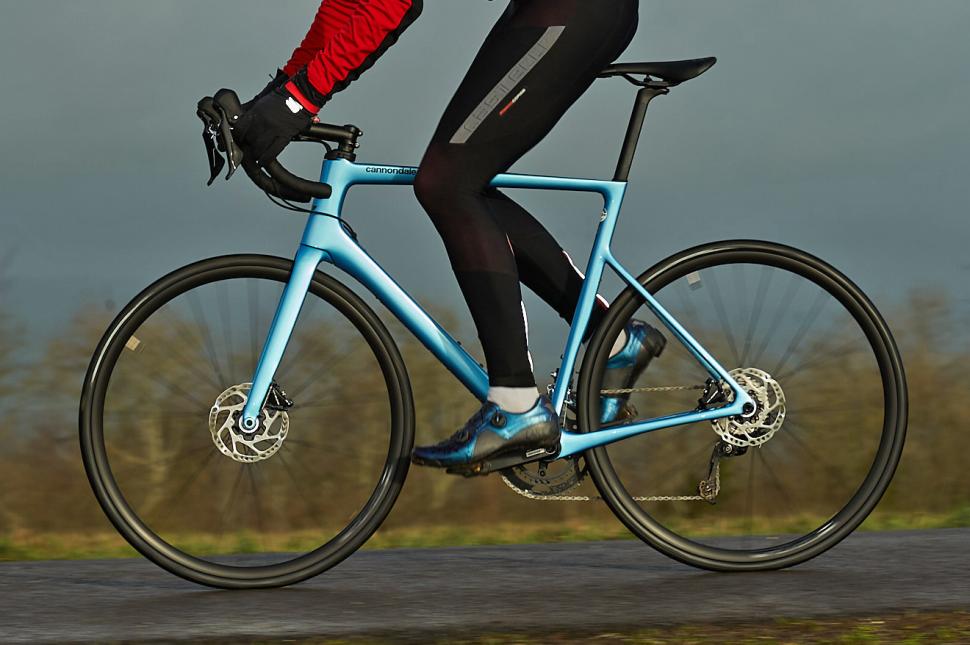
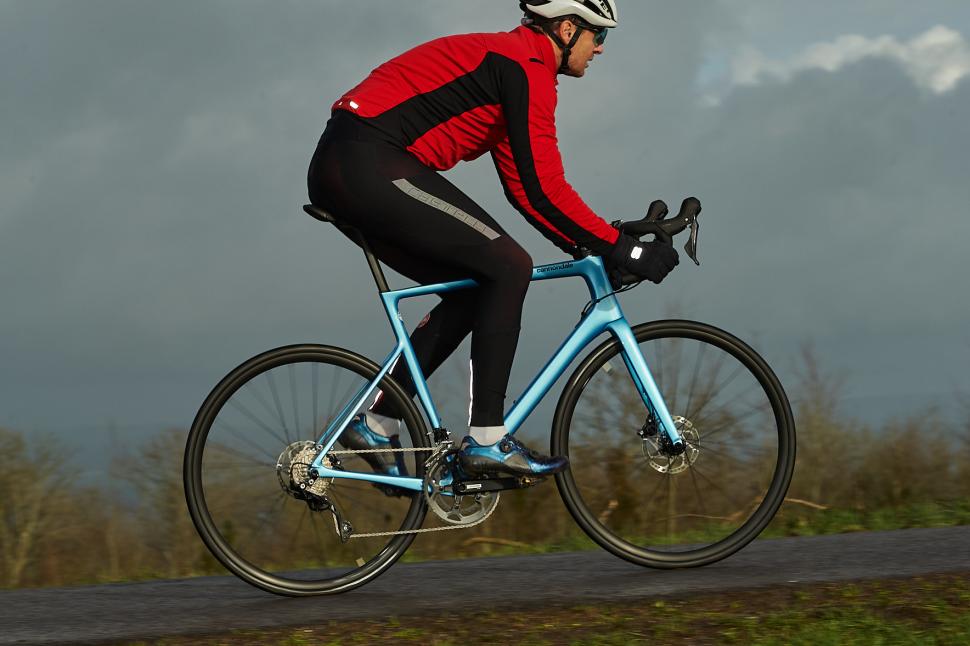
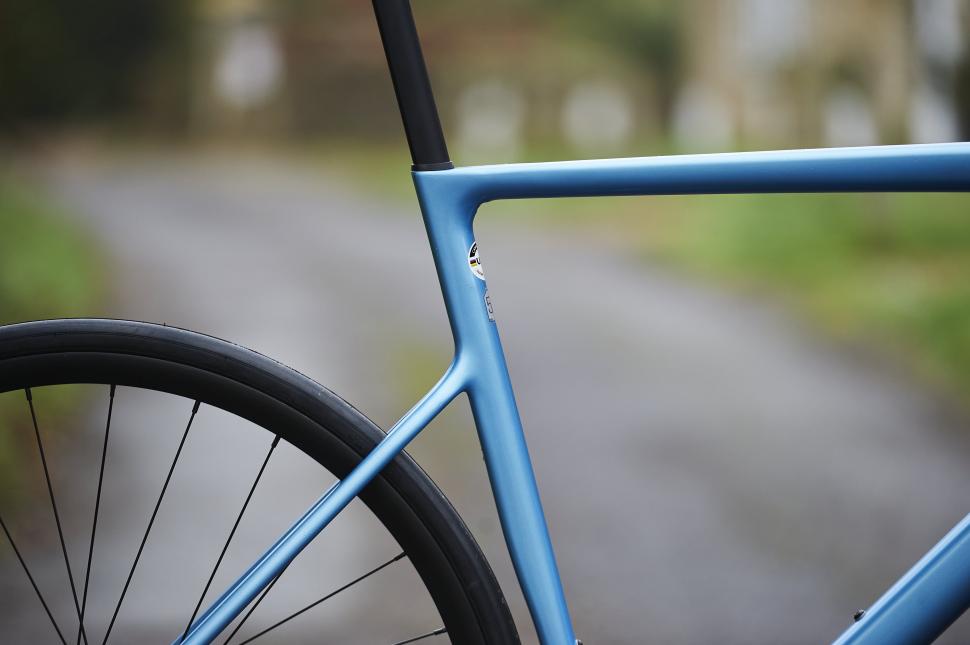

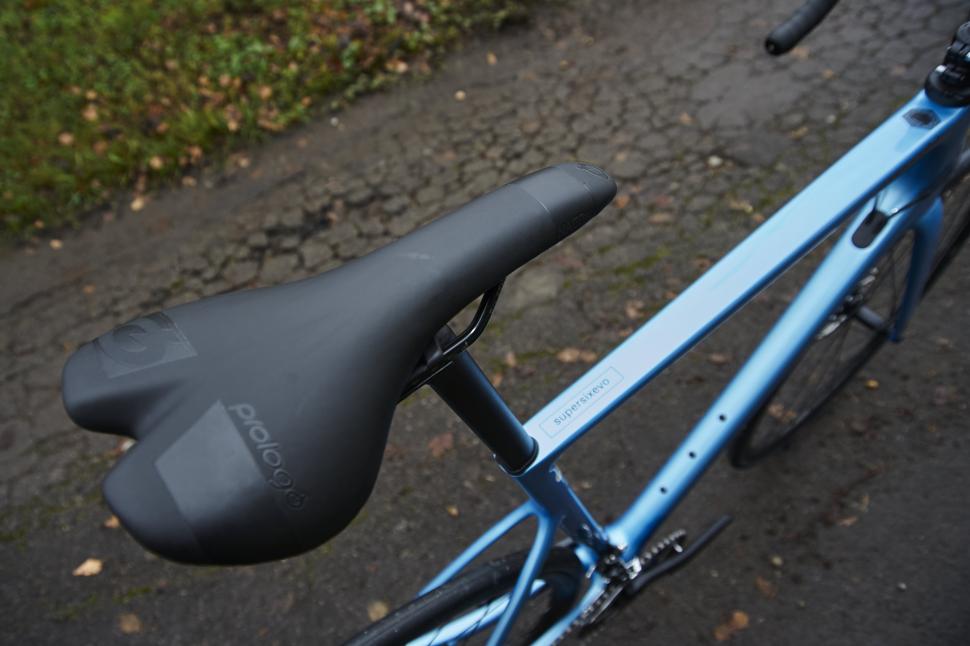

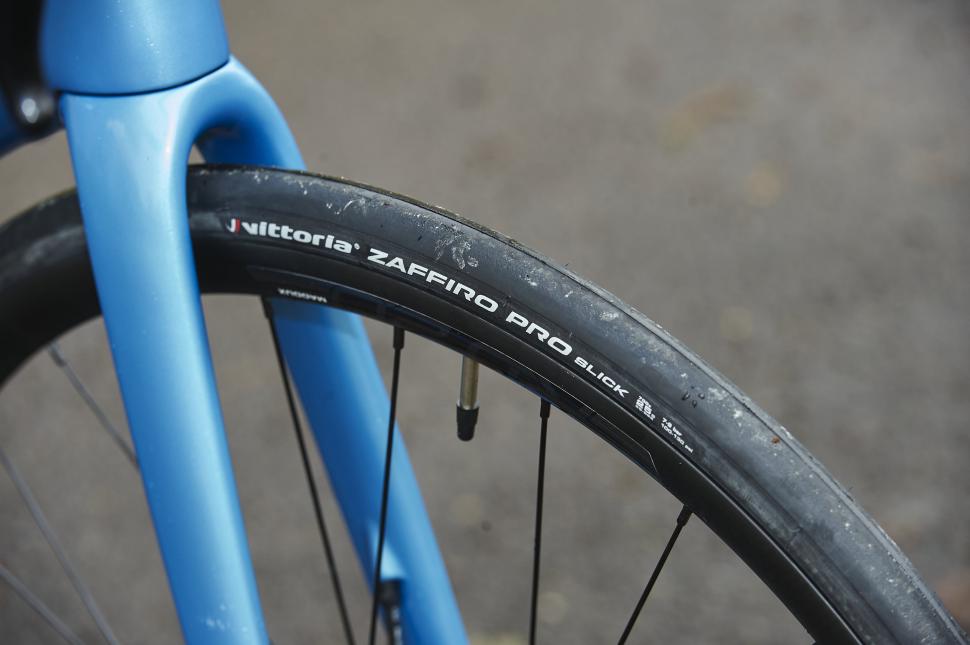
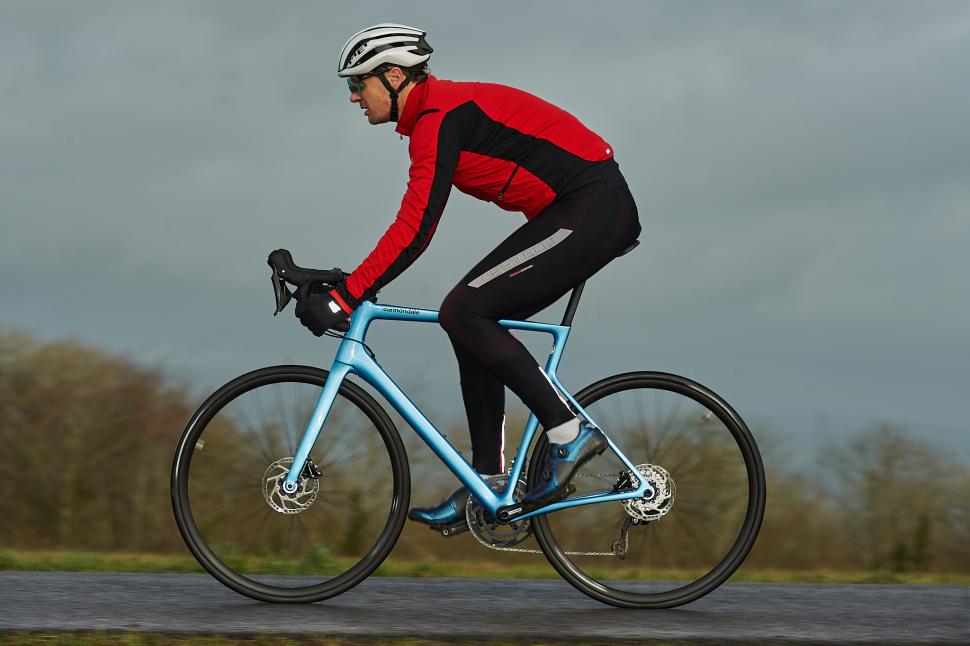
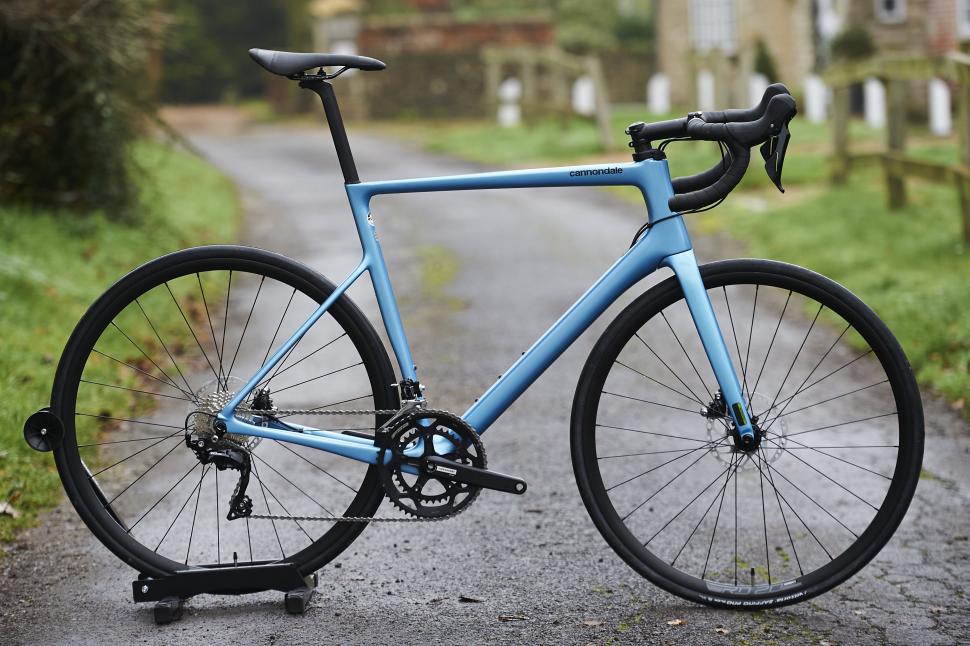
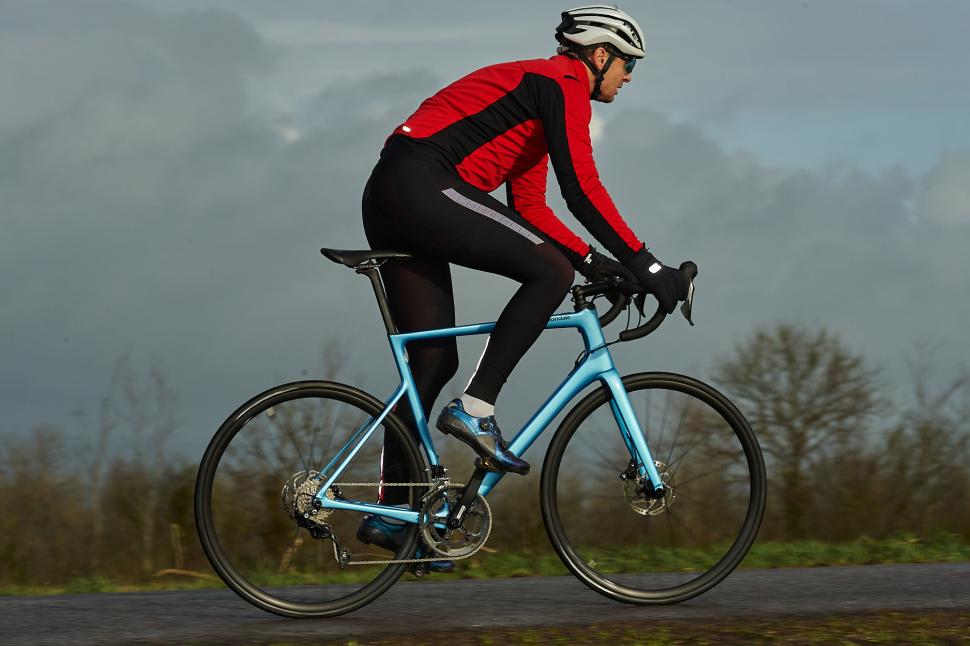
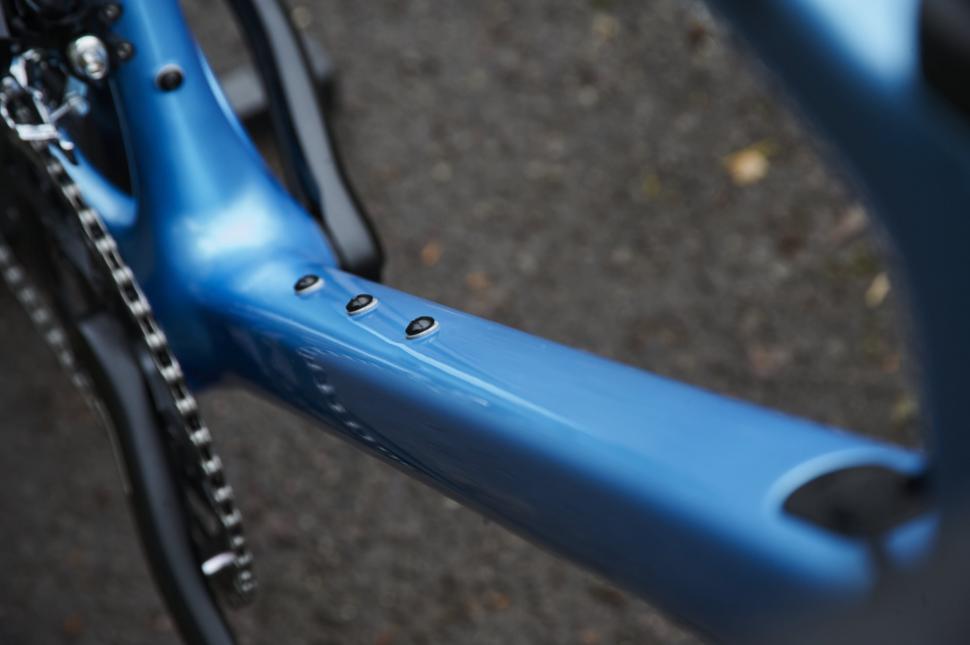
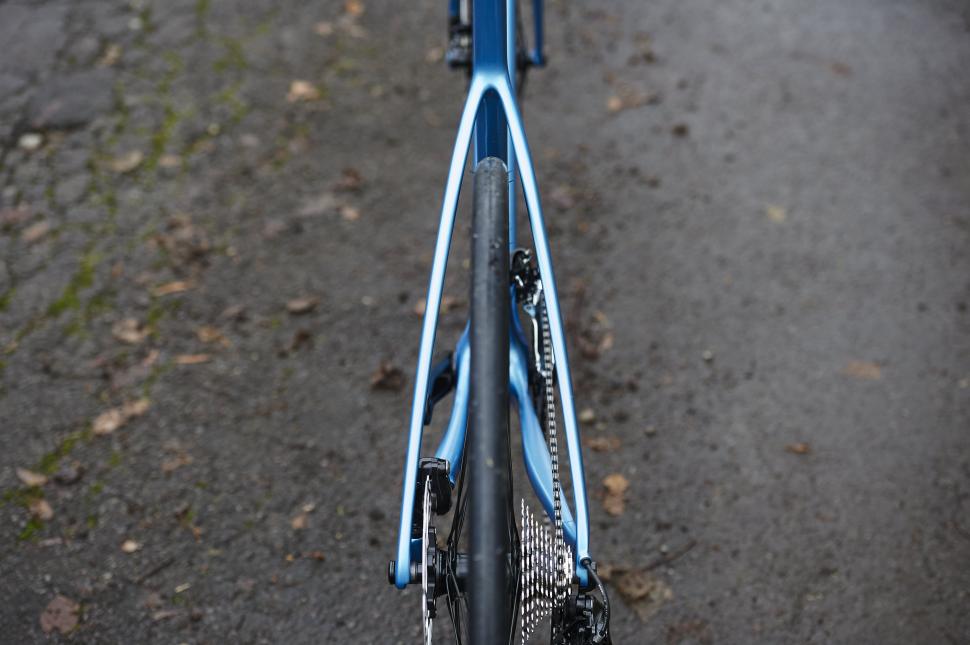


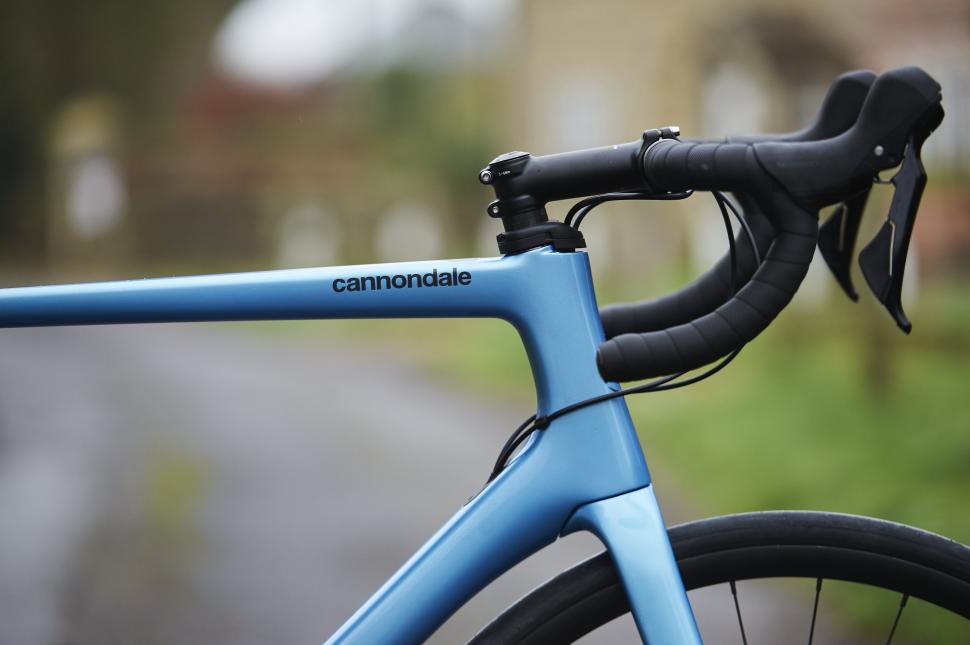
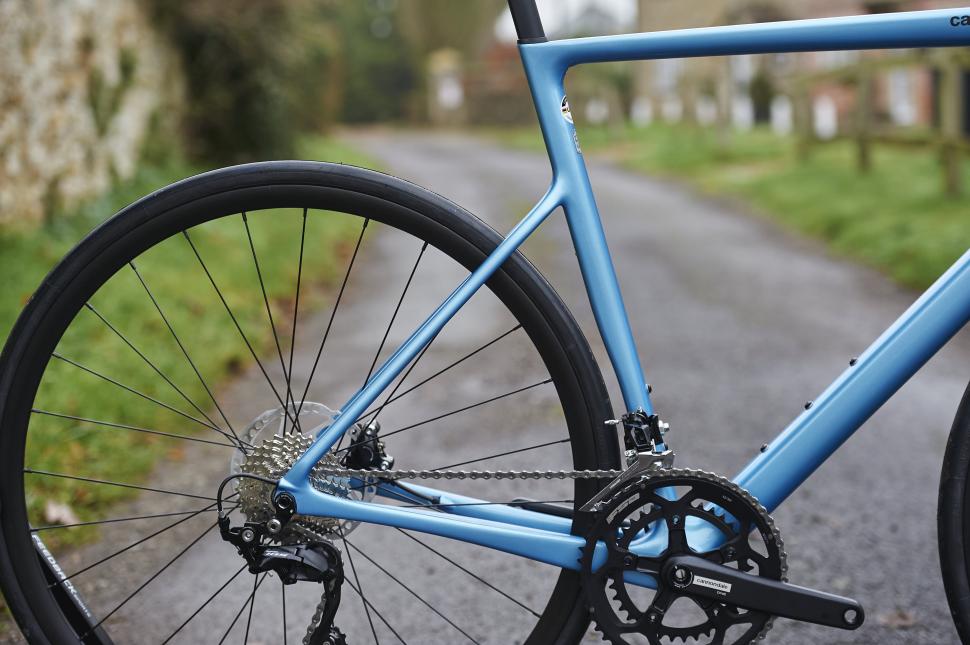
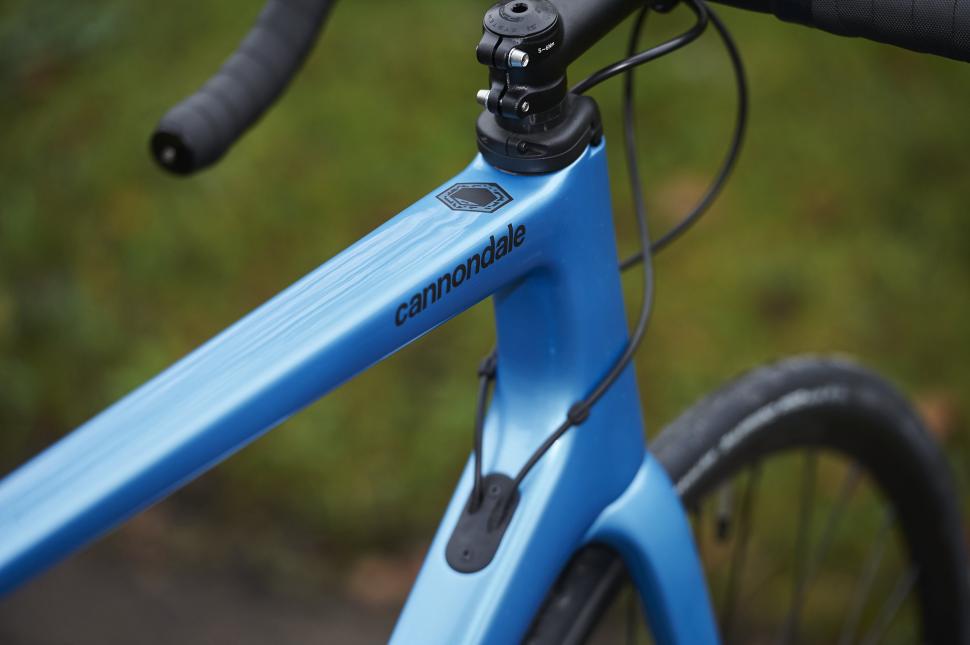

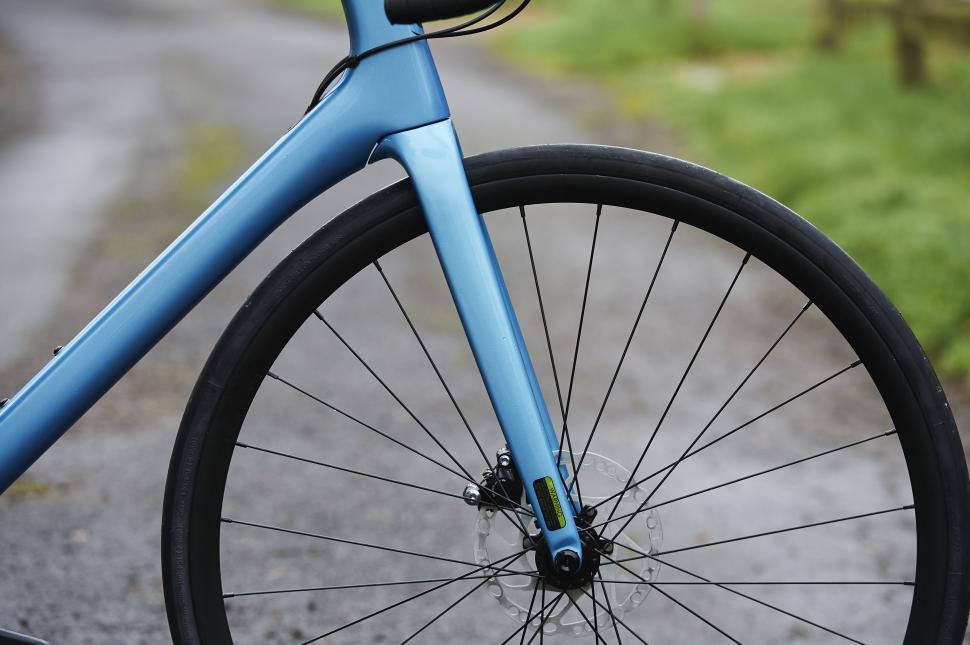
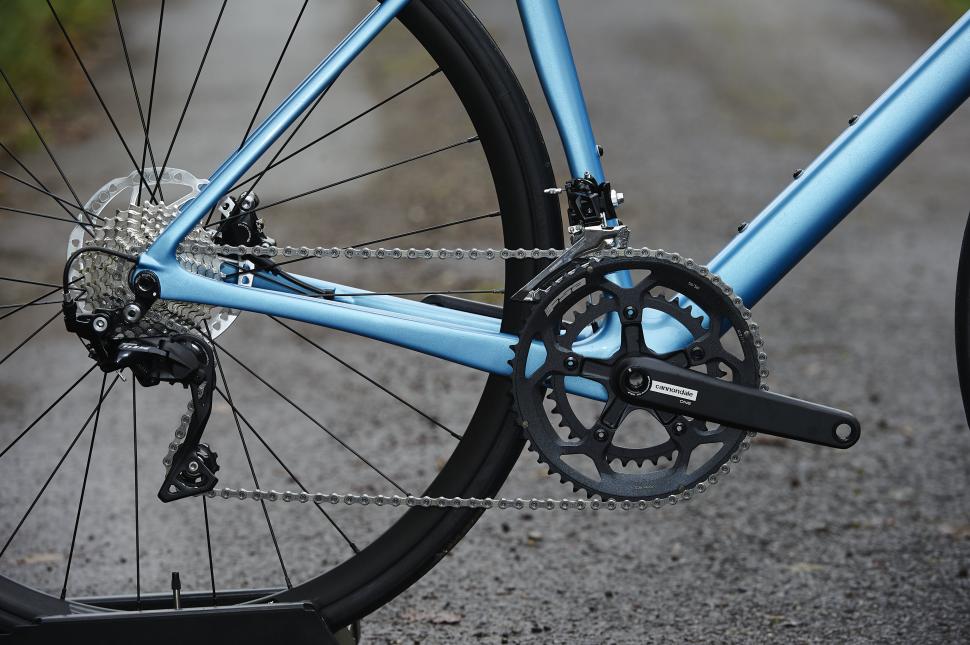
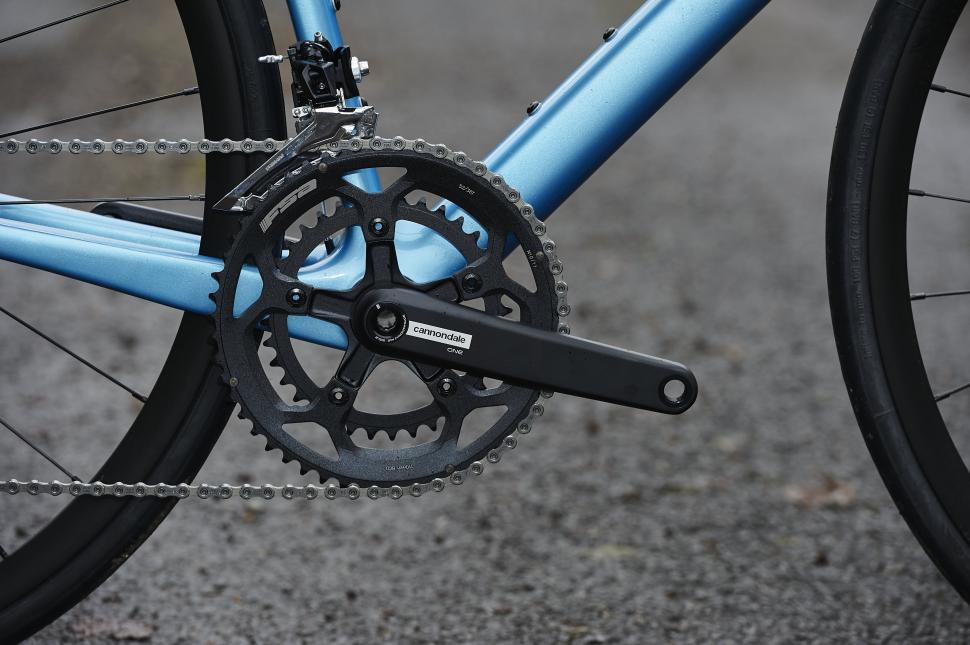

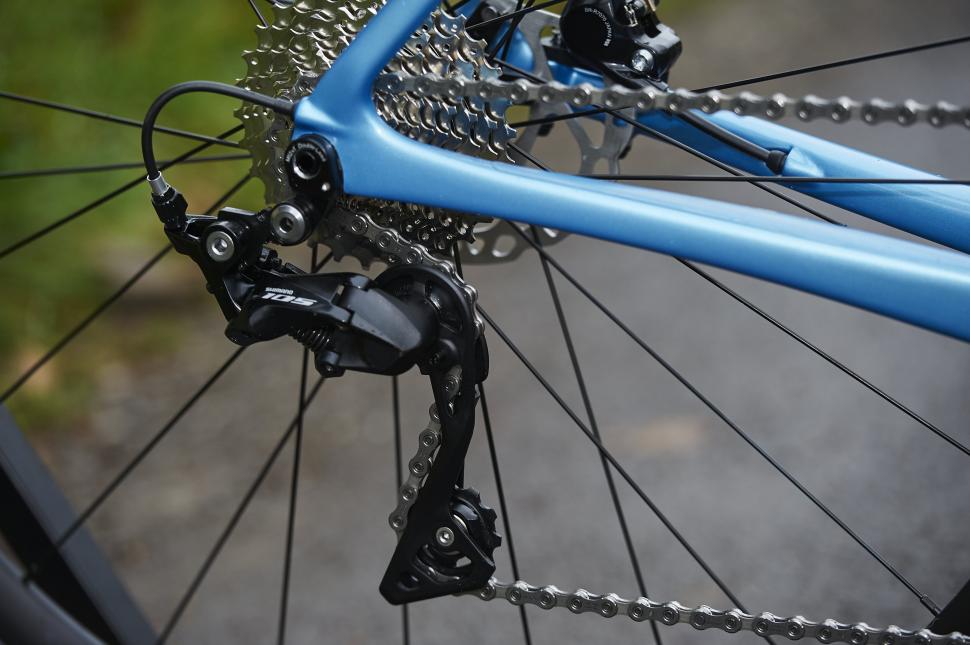
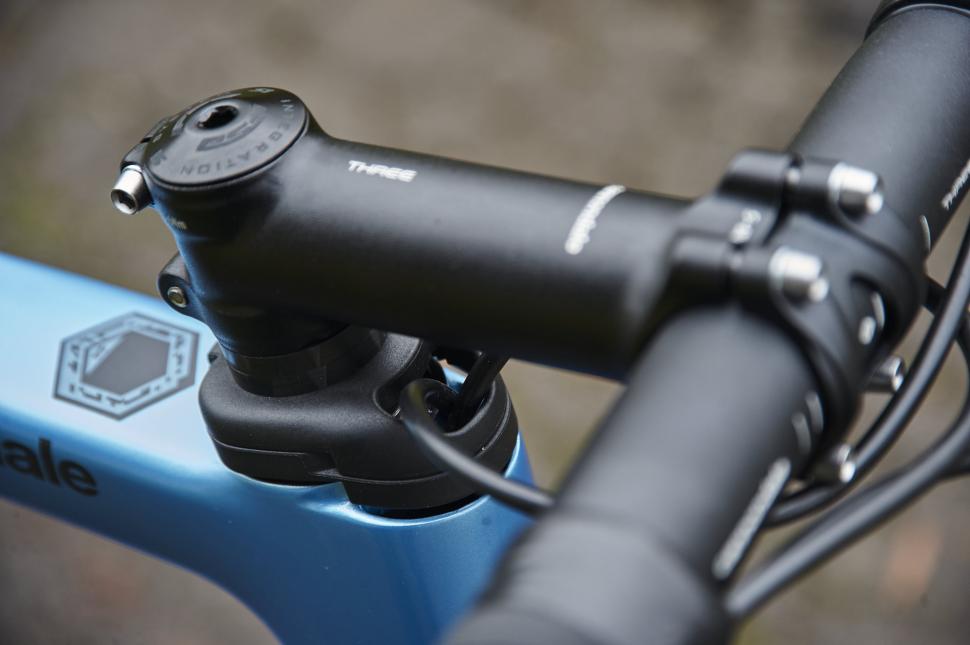
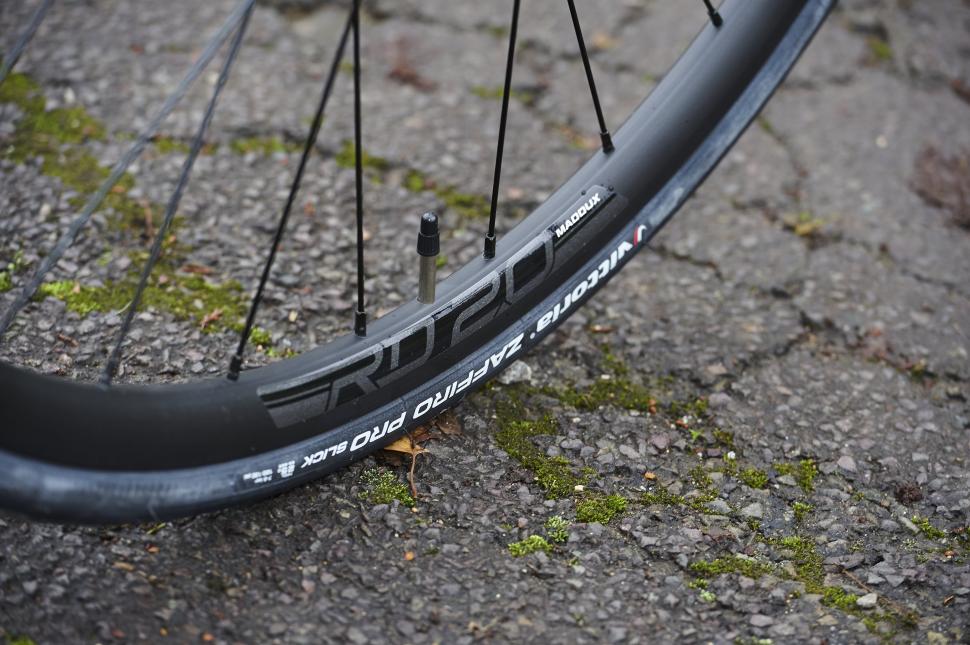




Add new comment
5 comments
Nice to see a decent bright colour in the cannondale range again - in the last few years the range has been really dreary and fails to emote the excitement or innovation that Cannondale normally associated with.
Great colour, but nearly 9 Kilos! ooof.
Looks nice, but far too upright for me.
The 'cockpit' area might be a touch clunky and the dropped stays will continue to split opinion, but in my opinion that's such a pretty bike. The pared-down graphics and tasteful colour are just lovely. And because it's a Cannondale, I've no doubt it will ride like a dream in spite of the slight weight penalty over some other options.
The price feels a bit pointy for a bike with 105, but that's market forces and exchange rates for you, apparently we voted for it, and with the shortages there have been this year you can't blame the makers for trying to cash in a little bit: Cannondale are hardly alone in this.
If I was spending £2500 on a bike? I'd definitely try it out.
Kind of a retro look: those dropped seat stays are so 2015.